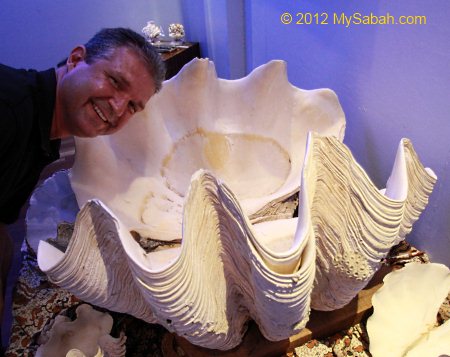
The Marine Ecology Research Centre (MERC) will release its first
batch of 500 giant clam juveniles back to the sea soon. MERC’s project
director, Alvin Wong, said during a press conference held at the Gayana
Eco Resort yesterday that after three long years, they have finally come
to the stage when they can release the juvenile clams, each measuring
about three inches in length back to the wild.
“It took us three years to get the clams to the three-inch size
they are now at and hope they will be able to thrive in the wild,” he
said.
The monitoring of the clams after their release will be continued to assess how well they thrive.
“If it doesn’t work, we will have to go back to the drawing block.”
Wong disclosed that it is not easy task to propagate all the
seven species of clams used to be found in the waters off the coast.
“It is a journey never done before and we don’t know if we would
be able to achieve our objectives, but today, we would like to celebrate
the success of the first phase of our struggle,” he said.
The first phase of the propagation programme involved producing
giant clam ‘babies’ through spawning and tending them until they reached
the stage when they can survive in an ocean nursery.
He explained the difficulty of getting the giant clams to their
current size, adding that the survival rate of fertility is a mere two
to three per cent.
MERC is unique in Malaysia to have spawned and produced giant clam spats of all seven species found in Malaysian waters.
If the endeavour proves successful, Wong said that they would be releasing more giant clams into the wild.
They currently have in stock a total of 2,000 ‘baby’ giant clams that would be released gradually, he said.







9 comments:
One of a number of large clam species native to the shallow coral reefs of the South Pacific and Indian oceans, they can weigh more than 200 kilograms (440 lb) measure as much as 120 cm (47 in) across, and have an average lifespan in the wild of 100 years or more
The creature's mantle tissues act as a habitat for the symbiotic single-celled dinoflagellate algae (zooxanthellae) from which it gets nutrition. By day, the clam opens its shell and extends its mantle tissue so that the algae receive the sunlight they need to photosynthesize.
Good information, Smookiekins. These giant clams can reach an impressive size of 120 CM and can live for more than 100 years. The Marine Ecology Research Centre (MERC) will soon release 2,000 ‘baby’ giant clams into the sea gradually in stages. The first batch of 500 juvenile clams will be released first.
Looks like you have extensive knowledge of these clams, not many people do. I hope through this MERC project on releasing the clams as well as the Ronan Keating promotion will help more people understand about these clams and why we should protect them. Thanks for leaving a comment with us, Smookiekins.
The Marine Ecology Research Centre deserves praises for their good effort in improving the giant clams population.
Hope that these 2,000 clams which will be released into the sea can thrive in the wild habitat.
I have never seen a real giant clam before, 120cm sure is huge.
currently Sabah has two places that spawn and propagate giant clams and you can see all 7 species of giant clams in their sites. the first one is Marine & Ecology Research Centre (MERC) in Gayana Eco Resort of Gaya Island, and another one is Sabah Parks Hatchery at Bohey Dulang Island..
no matter how hard and how long these two centres (MERC & SPH) try, they are only able to increase the population of giant clams in limited scale, not the whole ocean around Sabah. the conservation has to be started from we, the consumers. just don’t eat and buy any giant clam product and the killing will stop. eating giant clams is as bad as eating shark fin and turtle eggs..
Post a Comment